When technologies converge from rapidly fermenting disciplines like biology, information science and nanotech, the results become hard to predict. Singularities can emerge that create outcomes we cannot always anticipate. Rachel Armstrong explores this phenomenon in today’s essay, a look at emerging meta-technologies that are themselves life-like in their workings. The prospects for new forms of design in our living spaces, including future spacecraft environments, are profound, as ongoing work in various venues shows. Dr. Armstrong, a regular Centauri Dreams contributor, explores these issues through her work at AVATAR (Advanced Virtual and Technological Architectural Research) at the University of Greenwich, London.
by Rachel Armstrong

Three lumps of muck hit the breathing membrane. A scattering of fragments blew back at the boys as they shattered like crumbs.
‘You’re right! They disappeared!’ crowed the smallest of the trio. ‘That building literally – ate dirt!’
Despite its lumpy shell-like appearance, the irregular wall was strong – and warm to the touch, like a freshly boiled egg.
The tallest boy rolled out a makeshift stethoscope listening to the internal rumblings of the architectural fluids. “Come on! Lets’ get on with it.”
He motioned to the others with a beckoning hand. “Did you get the drill bit? He asked. “Let’s tap this thing before it feels we are here!”
With one standing watch, the other two pushed and ground the pointed metal extension into the surprisingly resilient surface. They finally forced the tip through with a hammer tap, into the soft interior, as the self-healing edges of the lesion squirmed, trying to close over the hole.
“Okay, where’re the containers?” the small guy barked, “We’ve hit liquid gold!”
Nanosensors in the broken crust transformed the semiconductor surface of the building skin into a sensor array. This awoke the surveillance gaze, which shivered at the intrusion, like a cow flicks its skin at a fly.
The maintenance doctor looked over at the disturbance, “Pesky tappers!” he sneered, as the dripping hole quickly closed over like a blood clot.
……………………………………………………………………………..

In 2003 Roco and Bainbridge prepared a National Science Foundation report (Roco and Bainbridge, 2003) that proposed a new kind of singularity, where cutting edge technologies – that were directly engaged with the building blocks of matter – converged on a common platform. Roco and Bainbridge proposed that when these NBIC (nano-bio-info-cogno) technologies were combined, the emerging platforms could radically improve human lives in many ways that would impact on a broad spectrum of human and economic activity. What is unique about the NBIC ‘singularity’ is that a method was actually proposed to induce such a technological tipping point and government money was invested to support the initiative in ‘sand pit’ initiatives.
During these events, participants were required to find new ways of working where the sciences could reach out across other disciplines to challenge traditional boundaries of theory, practice and innovation. Indeed, pursuit of the NBIC convergence led to funded ‘sand pits’ both by the NSF and EU, where multi disciplinary practitioners, predominantly scientists, collaboratively addressed ‘grand’ challenges such as, artificial photosynthesis. Additionally, further convergence across the Two Cultures is also being actively supported by the UK government as a STEAM (science, technology, engineering, arts and mathematics) initiative, where the contributory role of arts in innovation is supported and recognised as being integral to this process (Else, 2012).
An example of one of these NBIC ‘sand pit’ technologies is the ‘cyberplasm’ robot, which was constructed from cellular, bacterial and electronic components. Projects like these have arisen from the NBIC ‘sand pits’, a mélange of biological and mechanical systems (Cyberplasm Team, 2010). Yet such projects deal with the possibilities of NBIC in abstracted environments and potentially could be more meaningfully challenged in applied contexts.
A range of NBIC projects are currently in development. For example, at the University of Florida – when coated with carbon nanotubes and pressed between two sheets of Teflon, spider silk forms a composite that is sufficiently flexible and electrically conductive to detect the electrical signals from the heart (Steven et al, 2013).
While not a formal NBIC ‘sand pit’- my work as part of the AVATAR group at the University of Greenwich – embodies principles of NBIC convergence to produce ‘living technologies’ that are specifically designed for use in the built environment. These experiments have produced a wide range of drawings, models and prototypes that aim to provoke new forms of ecological design through collaborative partnerships with scientists working with experimental, cutting-edge technologies such as, chemically programmable dynamic droplets (Armstrong and Hanczyc, 2013).
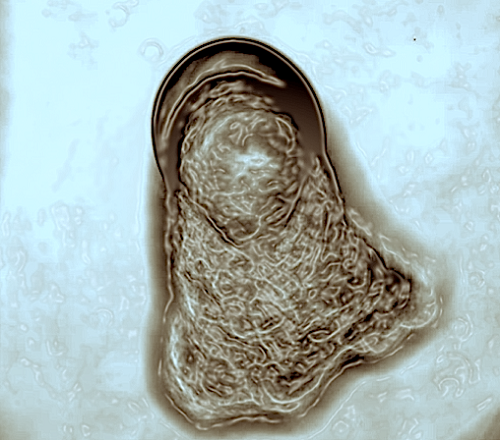
The challenge of collaboration between the disciplines is to explore how it is possible to venture into the very space in which our current predictive models break down when convergent technologies reach transformational tipping points – or singularities. These existence landscapes are not situated within the classical scientific frameworks but propose methods that deal with uncertainty and probability. This does not mean that ‘anything goes’, but that it is possible to be propositional about the exploration of possibilities within definable limits of probability. In other words we are encouraged to find unity in achieving a particular goal, through a diverse range of approaches. For example, there are a range of methods to produce self-healing materials that include seeding traditional materials such as, concrete with extremophile bacteria, as in H.M Jonkers work on ‘bio-concrete’ – to developing slow-release chemical delivery systems that respond to environmental changes (Armstrong and Spiller, 2011).
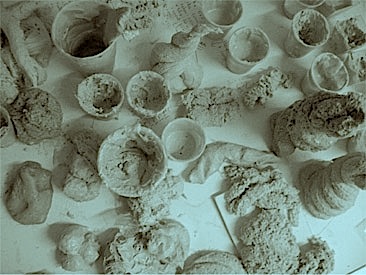
Since NBIC technologies form a conduit for different information fields, they may be explored using experimental methods to map and explore the material consequences of their impacts. These are most evident and accessible when materials themselves become processes, at far from equilibrium states. For example, the computational properties of matter can be demonstrated using programmable droplets designed with a specific metabolism so that one set of substances can be transformed into another. Droplets may be programmed to respond to carbon dioxide produced by visitors by changing colour and acting as artificial ‘smell and taste’ organs in the Hylozoic Ground installation, designed by Philip Beesley for the Venice 2010 Architecture Biennale (Armstrong and Beesley, 2011). These chemistries detect chemical changes in their environment in a manner reminiscent of our own sensory nervous systems.
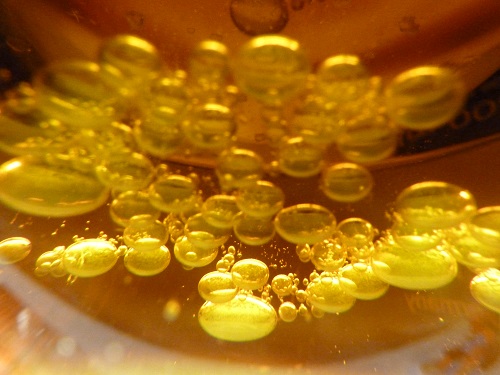
A range of lifelike emerging new (meta) technologies pose very different opportunities and challenges to machines (Myers and Antonelli, 2012) and work in ways that are much more like ‘life’. They possess resilience, environmental sensitivity, and adaptability, are able to deal with unpredictable events (within limits) and possess the capacity for surprise. Ultimately such convergent technologies may be able to evolve. They can and should reshape how we think about how to do the things we take for granted – so that the performance of our living spaces is not always measured in terms of mechanical efficiencies, but may relate to the qualities of experience such as, potency, or fertility.

Metaphors already associated with living bodies may best help us construct frameworks for imagining and working with these kinds of systems. For example, NBIC technologies may enable buildings to have organs, made from bioprocesses that can transform say, waste products into compost as suggested in Philips Microbial Home project (Microbial home, 2011). The outcomes of these technologies could be used to make native soils and form the fertile substrate on green roofs – rather than for example, transplanting rare bog soils, which is currently a common practice in our cities (Sams, 2012). They might also provide biofuels from algae, biogas from bacteria and organic waste, recycle water, provide food, adsorb toxins, grow building materials or even provide entertainment if their lively bodies are synchronized say, by speakers transmitting music from an i-Pod through the water system nurturing an algae colony.

NBIC technologies change the possibilities for design in our living spaces by opening up the kind of information we can use to construct spatial programs- perhaps like an advanced form of 3D printing where information is not separate from the material platform that it instructs. Dune is a speculative proposal by Magnus Larssen, which imagines an architectural scale biofilm with a metabolism that fixes sand into sandstone (Myers and Antonelli, 2012). Other systems can precision process matter at the molecular scale such as, the production of molecular objects reminiscent of floral arrangements (Villar, 2013).
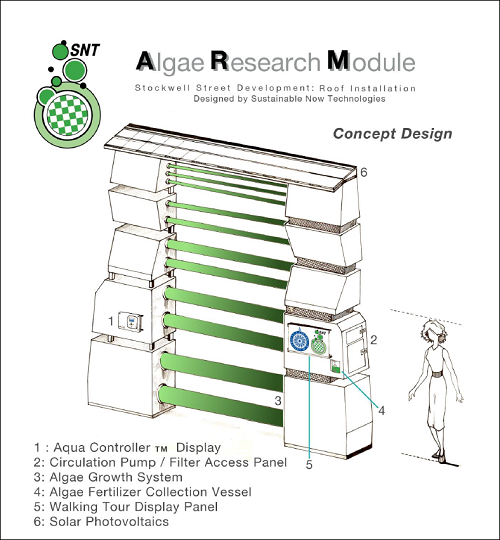
Lifelike NBIC technologies may help us find abundance and facilitate growth within our cities by changing the way that we think about what these terms mean and enable to deal with them differently. Rather than establishing what kinds of distribution systems can bring raw materials to centralised production centres, NBIC technologies allow the distributed harvesting of resources by systematically searching a broader solution space than is available for traditional industrial processes, as they are able to connect across a variety of different information media. NBIC technologies scour what Stuart Kauffman calls the ‘adjacent possible’, by identifying local processes that already exist within environments (Kauffman, 2008). They draw together the chemical fabric that underpins the metabolic hubs of organization, which draw the threads of transformation together in the presence of abundant resources such as, waste, carbon dioxide, or naturally occurring cellular processes in microorganisms. NBIC platforms then orchestrate these processes, shaping their material outcomes through understanding the material limits of possibility that define their individual interactions.

For example, an algaeponics unit is being installed on the green roof of the new Stockwell Street building at the University of Greenwich is a research unit, which will establish the parameters of operation of such a system in the London area. Having been built in Longbeach, California, where the current expertise lies, it will spend its first year harvesting data on the performance of the local, London algae species that inhabits its liquid infrastructure. This will give us information about how much biomass a unit can produce and therefore help us design say, a biofuel station on the Thames estuary for local river traffic.

A powerful historical precedent using much simpler techniques than are currently available by applying biotechnology, has already been established for natural computing during the agrarian revolution, where livestock lived underneath, or shared our spaces at times when space and natural resources were much less constrained than in megacities today. Yet, NBIC technologies may be thought of as being a form of agriculture for the 21st century where tiny synthetic ecologies are optimised for the megacity environment through hyper-efficient biochemical networks. It is not inconceivable that miniaturised forms of natural processing may be developed a whole palette of synthetic physiologies through harnessing the metabolic power of microorganisms since only decades ago our modern computers filled an entire room when now – they fit within the palms of our hands. Such systems could conceivably be housed in specially designed synthetic ‘organs’ within under-designed areas in our homes and workspaces – such as, in cavity walls, ceilings and under floors. Over the last year or so, I have been working with Astudio on their 2050 postcard project, where alternative futures for the city have been shaped.
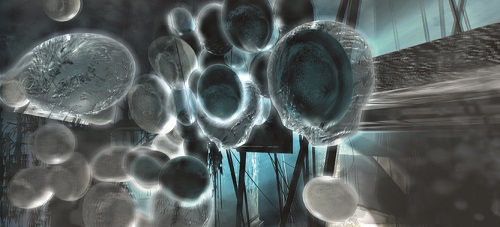
It appears that these new sources of abundance in the flow of matter through urban spaces potentially make most economic sense at a community level. Potentially the pooling of organic matter from urban markets could be anaerobically digested to provide under floor heating, native soils or biogas for local homes and businesses.
Indeed, NBIC technologies may punctuate the desert-like concrete urban environment with micro-oases of material abundance. Initially, these fertile islands may offset the need for nonlocal provisions and later, may even replace some of them entirely. At an urban scale, these extra metabolic pathways forge a giant biochemistry network that enable us to go from one substance to another without any intermediaries, or by increasing the biotic value of substances. Within these systems, innovation may freely flow as inventors find ways to divert, uncover and reshape the fundamental exchanges in material flows within cities by using different kinds of NBIC species. Perhaps these could be thought of as being ‘metabolic apps.’
By subverting the expectations of the material realm, NBIC technologies may transform urban landscapes into post natural fabrics. Designed, or synthetic, ecologies could therefore be produced by the seamless entangling between technology and natural systems that work with the innate creativity of the material ream and reinvent conditions for urban living – where landscape and building are not separate, but entwined. In embracing these new processes, notions of sustainability do not make best sense when evaluated according to globalised LEED and BREEAM standards that constrain these potential new fusions through geometric barriers that currently form our buildings but are much more meaningful when they are locally shaped as community contracts. Such treaties between participants may go beyond human needs and extend to agreements for nonhuman agents such as, trees, flowers and other wildlife.
How these kinds of technologies articulate new values attributed to productive living spaces, is yet to be established. Indeed, an intrinsic aspect of my research and exploration of the potential impacts of NBIC technologies is in using speculative fictions to reflect on their possible social, ethical and economic implications. For example, smart droplets may be programmed to accrete an artificial limestone reef under the city of Venice, which stands on woodpiles, to attenuate it from sinking into the soft delta soils on which it is founded.
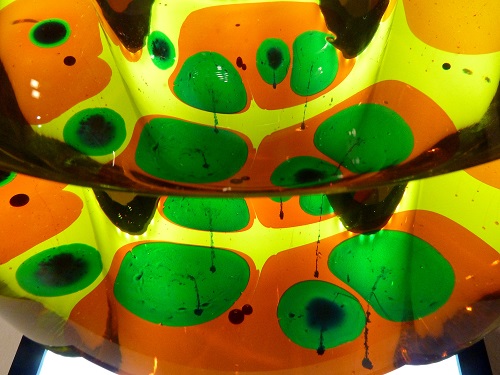
Future Venice is an architectural project that articulates how programmable chemical agents may be designed to move away from the light and produce solid matter as a way of growing an accretion technology under the foundations of the city, which rests of woodpiles. The dynamic properties of droplets have been demonstrated in the laboratory (Armstrong and Hanczyc, 2013) and also on the lagoon side in Venice (Rowlinson, 2012).]
Having a working experimental knowledge of these systems enables informed reflection on their performance in the laboratory, which can be extrapolated and compared with our expectations of other lifelike systems such as, biology, meteorological events or geological processes and combine these with our current ambitions for ‘ecological’ living.
Obviously, a singularity such as NBIC convergence may significantly contribute to changes in environmental, social and economic interactions – the specific details of which are not yet – and by definition, cannot yet be known. However, it is likely that the creation of new sources of wealth generation within our proximate spaces will affect our perception and expectations of what we mean by abundance and growth within resource-constrained environments such as, megacities – or worldships.
For architecture, a set of values that are interwoven with ecological systems requires the built environment to be considered differently – not as a machine, or as an extension of industrialization – but as an engagement with the technology of Nature, which is robust, unpredictable and resilient. Indeed, with the increasing likelihood of climate related events and severe weather patterns over the coming century, it is vital that our homes may not only provide us shelter but also become our life support systems when central power systems are hit by floods, winds or even terrorist attacks. Under these circumstances, the very fabric of our homes may then supply us with a limited amount of food, water, heat and process our waste so that we buy time before the traditional infrastructures are repaired and rebooted.
In everyday terms this means that we may experience our megacities very differently. For example, districts may potentially be mapped according to their local metabolisms where for example, water rich communities may set up local trading systems with compost-dense societies. Since matter is transformable, urban environments may even be cleaner as matter will be considered harvestable and not scattered as garbage in the street. Potentially then, fewer vermin infiltrate the city as they have less to feed on. Maybe, when our homes become organ stressed, we will send for building doctors who will collect the failing ecology and replace them with seeded matrixes that will evolve into mature metabolic ecosystems to nurture, warm and protect us. Collectively they may establish a new platform for human development that is primarily life promoting – that work in synergy with our current model of resource conservation – where our homes, businesses and cities are actually an ecological fabric that is forged by the continual, collaborative expression of a lively, material world, which increases the probability of our collective survival both here on earth – and also in constructed habitats beyond the earth’s surface.

……………………………………………………….……………………
The guts of the system were soon full of the potent golden liquid. It gurgled joyfully as the energy stomach growled, satiated.
It wasn’t the usual bio-engine that metabolised for a household but had been super-boosted by the maker community to provide enough organic power for the whole neighbourhood. Helpers had brought water vessels, which were on stand-by in case a sudden surge of chemical activity caused the system to break out into a sweat.
“Stand back!” commanded the tall boy as a mulling crowd became a little too curious about the workings of the operating system that had started to bubble as if it was boiling.
“We have enough embodied energy here to power up all the organs in your buildings! It’s too late now if you’re not already plumbed in to the community physiology. It’s going to get hot!”
But they didn’t need coercing. The standers-by quickly shuffled back as the heat from chemical bonfire surged. They watched the precious juice pump from the makeshift container into their living spaces, keeping time with its amber heartbeat and swore amongst themselves they’d keep it fed.
An old woman soaked in shadows shook her head, her applauding eyes full of wonder.
“I just can’t believe it!” she muttered through a mouth full of tooth implants. “We are finally ‘off the grid!'”
……………………………………………………………………………..
References
Armstrong, R. and Beesley, P. 2011. Soil and Protoplasm: The Hylozoic Ground project, Protocell Architecture, Architectural Design, Volume 81, Issue 2, March/April 201, pp. 78-89.
Armstrong, R. and Hanczyc, M.M. 2013. Bütschli Dynamic Droplet System. Artificial Life Journal, 19(3-4), pp. 331-346.
Armstrong, R. and Spiller, N. 2011. Synthetic Biology: Living Quarters, Nature 467, pp.916-918.
Cyberplasm Team. 2010. Cyberplasm: a micro-scale biohybrid robot developed using principles of synthetic biology. [online] Available at: http://cyberplasm.net/. [Accessed 18 April 2013].
Else, L. 8 August 2012. From STEM to STEAM. Culture Lab, New Scientist. [online] Available at: http://www.newscientist.com/blogs/culturelab/2012/08/john-maeda-steam.html. [Accessed 19 April 2013].
Kauffman, S.A. 2008. Reinventing the Sacred: A New View of Science, Reason, and Religion, First trade paper edition. New York: Basic Books.
Microbial home. 19 October 2011. Design Probes, Design Portfolio, Philips. [online] Available at: http://www.design.philips.com/about/design/designportfolio/design_futures/micro- bial_home.page. [Accessed 17 April 2013].
Myers, W. and Antonelli, P. 2013. Bio Design: Nature, Science, Creativity. London: Thames & Hudson /New York: MOMA.
Roco, M.C. and Bainbridge, W.S. 2003. Converging Technologies for Improving Human Performance, Nanotechnology, Biotechnology, Information technology and Cognitive science. NSF/DOC-sponsored report. Dordrecht: Springer.
Rowlinson, A, 2012. The woman regrowing the planet. Red Bulletin, March 2012, pp. 76-81.
Sams, C. 20 April 2012. Gardeners should end their love affair with peat, Green Living Blog, The Guardian. [online]. Available at: http://www.theguardian.com/environment/green-living-blog/2012/apr/05/gardeners-peat-carbon. [Accessed 20 December 2013].
Steven, E. Saleh, W.R. Lebedev, V. Acquah, S.F.A. Laukhin, V. Alamo, R.G. and Brooks, J.S. 2013. Carbon nanotubes on a spider silk scaffold. Nature Communications 4, Article number: 2435 doi:10.1038/ncomms3435.
Villar, G. Graham, A.D. and Bayley, H. 2013. A tissue-like printed material. Science, 340(6128), pp. 48-52.



NBIC Technologies….
Music and plants….
Music is vibration…
Strings are vibrations….
The word of God is vibration…
Are plants responding to differing vibrations in unexpected ways….
This could lead to a new universe of thought for ordinary men….
Measurable proofs….not conversation….will be required….
Torn between the optimist & the skeptic; but necessary if we ever do anything this radically innovative. The ‘greenness’ of this system is fabulous, but how do you integrate anything new like this into existing systems?
Would a developing country wish to test sponsor this in one of its communities? After ‘Bhopal’ had that nasty fertilizer plant eruption, the 3rd world is highly suspicious of anything with an advancing western agenda.
The brilliant combined nature of these technologies could be exploited on the ISS? Closed cycle life support is consider a recommendation since the Augustine Commission reviewed the essential goals for any proposed future manned space activities.
Consider the precedents from solar panels to beer brewing to penicillin: there is a place for advancing these kind of projects.
But my generation was promised “undersea cities’, ‘pennyless atomic energy’ & ‘the cure for cancer’.
‘Singularity’ is bantered around alot, but every advancement tends to insert itself & gets watered down… where is the technology revolution if it can’t be integrating into a scheme that actually puts equity into our culture?
What needs to be improved is administration and proponent distribution.
I’m not a raving socialist, but advancement of science and technology for the public good can only be effective if the public has a sense of collective welfare? But I’d love to visit a sustainable system where the standard of living actually goes up?
http://www.new-harvest.org/
In 2365 the great plague reached the once great city of London. No one knew where it had started. Perhaps a biowarfare agent developed in the East. Possibly biohackers in Eastern Europe. Whatever it’s start, the plague swept Europe. Unlike its earlier namesake, it wasn’t the various human species that were the victims, but rather the living biotectures that had replaced the old stone, steel and glass structures that had been the staple of the great cities of the past. The symptoms were the same wherever the plague struck. The infected buildings started to use up their resources fighting the infection. Then their systems started to fail. Then they lost control of their functions and their structures broke out in black pustules, the stench of putrefaction overwhelming to the inhabitants. The connected structures, once so supportive of the city’s ecosystem now betrayed the city, spreading the infection to all the structures. Within just a few weeks, the city had died, leaving the residents to fend for themselves. The very success of biotecture doomed the inhabitants. With no functioning chemical industry left, and very few simple, physics-based powerplants, the inhabitants, were left without an alternative means to survive. Only the abandoned subway systems offered some shelter from the elements as food and water rapidly ran out. The very complexity that made biotecture so resilient, proved impossible to protect, despite the heroic efforts of the bioengineering pharmas and city ecologists. As billions died, the surviving populations were those that had stayed with their traditional architectures. These had proven simple to construct and easy to maintain, resistant to the chaotically rich synthetic biologies that strode upon the world. Human civilization collapsed back to the almost unimaginably simpler world of the late 20th century.
What a fascinating essay. This is futuristic, open-minded thinking big-time.
I think that seriously, scientists need to use nature as a big part of making the world or worlds much grander places for all of us to live and truly experience life to as high a standard as possible.
I think that inevitably when a way of thinking is both radical AND well thought out with strong foundations in theoretical capability, then there is perhaps a natural response from some to become fearful. And yet, if we stay stuck in 20th Century thinking – all we will ever become is what we are now, and with the world the way it currently is, I don’t think that would be a good thing.
Something that crosses my mind when thinking about objections that people would put across regarding the idea of living, breathing homes is this: People might say that the risk of spreading biological catastrophe between homes would be inevitably disastrous but I disagree. So far, humans have survived every single plague to yet evolve. And yet, there is one key difference between a living, breathing humans and a living, breathing building: humans are mobile, buildings are not. If mobile beings can survive biological contagions, then stationery buildings defintely could. Not to mention, buildings are much easier to manage than humans.
I also loved Dr. Armstrong’s idea that living spaces could become so much more than just places of shelter. The thought that they could become integral to enhancing our physiological and perhaps even emotional well-being is just so incredible.
Surely the definition of a ‘living space’ is one that would be well defined as a place that truly enhances our enjoyment of life itself. Instead of residing where we live, we could live better where we reside (in addition to living when outside too I mean.)
I think Dr. Armstrong’s ideas are phenomenal and we should entertain more of this kind of stunning thinking. In fact, society MUST entertain more of this kind of thinking. We need people like Dr. Armstrong.
Thank you very kindly Centauri Dreams for providing such fascinating food for thought. I really enjoyed this and am sure I speak for many when I say that I hope this great site continues to attract people like this lady to write for them! Centauri Dreams well done guys.
This here described, like all hopeful technological innovation, is intriguing and well worth pursuing. But without stemming our predilection for reproducing like mice, no technological innovation will prevent our inevitable demise.
The big issue with biological cities is that they can, well turn on you. If there was a mutation in part of the organisms that make up the cities it could well become a nightmare world instead of a paradise. Best a synthetic world with life we know adapting to it, then we have some control over the situation.
Biological cities make sense given that “wet” nanotechnology based on synthetic biology is likely the only form of nanotech we’re going to get. Biological cities have the advantage of being “grown” rather than manufactured, thus reducing capital cost of their creation.
Awesome post, Paul!
Been thinking about the notion of technological enhancement of the human body including the brain.
Oddly enough, such enhancement would be effectively preternatural except accomplished with natural technology.
I remember reading an article in Popular Science or whatever, I’m not sure of the source, where the concept of a tree that grows into the form of an enclosed house was discussed. The tree being squat and thick-walled could be several time stronger that a brick and block house.
Synthetic biology and ecology is something that we should be alert to as we send our first probes and human crewed starships to our stellar neighbors.
@Jamie
Tree species have been almost completely wiped out by diseases. Their immobility didn’t save them. e.g. Dutch_elm_disease
@Abelard
Possibly, but not necessarily. They may require pharmaceutical levels of capital for their development and even growth. Conversely, we know that trees grow quite well with little help, and can be cut and sawed into lumber for construction of homes with very little capital. Pre-modern Tokyo was almost all wood-based construction. One problem with growing houses is that not one will be exactly the same. This may be desirable in some ways, but it will also mean that every fixture and fitting will have to be custom. That will have extensive ramifications.
It is quite likely that we will see bio-mimicry used for dwelling components, allowing for new properties and functions. However, I doubt full scale biological houses will catch on. We’ve seen many ideas about buildings by architects over the last century, but funnily enough few have had much impact, even when they have been demonstrated to work well. Humans seem very conservative in house design and even put in place barriers to innovative design to stifle it.
Someone sprinkled a tryptamine in your New Year’s Champagne? ;-) Great essay! If we want to try to understand what the future holds for mankind, we have to break the limits of what we think is possible and there is art and imagination probably the best tools. And what better time than the start of a new year to imagine the future. Then we can use the rest of the year to be empirical and get our equations to fit.
Thanks for this intriguing look at what the future might hold, certainly more interesting than the computer-only metaltech singularity that is usually envisioned when these kind of subjects are discussed. I like the idea of incorporating biology into buildings, that’s the kind of thing that may come in handy to help mitigate against the ecological crises humanity appears to be rushing headlong into.
Yes Alex Tolley, biology is a wonderful thing, and ‘punishes’ anything that attempts to add needless complexity and structure to the ecosystem. Remember that current best estimates are that there are ten viruses for every living organism – and that viruses can only live a parasitic existence. Those that can exploit the best for their own selfish ends are the winners. Also note that most living organisms are ‘prokaryotes’, and that there are quadrillions of these for every complex organism that weighs in the kilograms. Even if not a single one of these was a pathogen, they most certainly are competitors, and the environment must be an extremely tricky one where all those complexities can be ‘justified’ for higher eukaryote to ‘win’ (ie stay alive). Add nutrient to a river (thus making things easy for life) and it explodes with biomass and productivity – biology doesn’t care that these are only slimes, moulds and algae – no matter how much we would prefer it to be fish and river weed.
@Rob Henry – you raise an interesting point that I had missed. Biotecture a la Armstrong may or may not use the new synthetic biologies (I assumed she would given her Black Sky essay for worldships). No lesser eminence, George Church in “Regenesis” assumes that we can tailor synthetic biology so that it will not interact with natural biology. Disease free humans, etc. The hubris is that synthetic systems will not evolve parasites (with or without help from natural systems). Our cities have stood for hundreds, in some cases thousands, of years. Biotecture seems much more ephemeral to me, and if vulnerable to parasites will need to be replaced (regrown) so that cities will be more like managed grassland than forests.
@Alex Tolley
Wonderfully written, but don’t you think that the future cities will be build from many competing organisms, rather than a single one? If some living systems are designed by International Bio Machines, and others by Spartan systems, how likely is it that a plague would affect both types or organisms?
In that sense, I believe your plaques is unbelievable and not a valid critique.
And one would expect an artificial living organism to be provided with the full spectrum of protection systems that a natural living organism has, since mutations are inevitable. And artificial living organisms will certainly look like food to natural ones. I can imagine, first a rat, and then a lot of rats, living contentedly of the golden syrup…. some kink of protection will e required. And that also should make the maga plague you describe impossible.
Regards,
Michel Lamontagne
Hi Rachel,
The language used for the article was a pleasant change from the usual dry descriptions. And the stories were a good illustration. But illustrating something effectively doesn’t mean it exists. And two basic points were not really addressed here; energy usage and mobility.
The golden syrup is most probably oil. Decades of research and billions of years of evolution have not created any liquid with a higher energy density. Any internal composition of that fluid that are not oil will reduce it’s efficiency, so billions of little makers in the oil is an unlikely scenario.
Golden syrup being notably difficult to pump, for example ;-) the efficiency of the organism will go down. Solar energy alone, at the low levels of availability it has in nature, combined with some form of organic pipeline, will not provide dense enough power networks for high levels of activity. At best, nature has provided the sugar maple, and the concentrated sugar is pretty thin fare, required tons of firewood to concentrate it to usable levels…
As far as mobility goes, large organisms, such as corral reefs and trees, are mostly composed of dead, not living materials. Something like 95% of a tree is dead, and a much higher percentage in a coral reef. In that sense life is much more like a coating that a deep phenomenon, and life uses dead structure to get to resources. A tree creates a dead core to get to the sunlight. In that sense a city is already an organism, where the living surface (us) uses the dead structure to support its activities.
That every ecological niche in the city is not yet occupied is not surprising, since they are recent constructs, but that will happen eventually. That the organisms that become included in the city’s fabric be useful to us is an interesting objective, and that the act symbiotically is also a gain. But I wouldn’t call it post biology.
Regards,
Michel Lamontagne
@Alex Tolley
“Tree species have been almost completely wiped out by diseases. Their immobility didn’t save them. e.g. Dutch_elm_disease”
And how many of these trees were visited by tree doctors? I see your point but in my humble view, it isn’t comparible to the situation envisaged by Dr. Armstrong. At the end of the day, cavemen could have stayed away from playing with fire, for fear of being burnt, but I guess they decided it was worth a go.
I thought it was an inspirational, beautiful article and all credit to Centauri Dreams for throwing this out there to be debated, chewed upon and in my case, savoured for the critically thoughtful delicacy that I believe it to be.